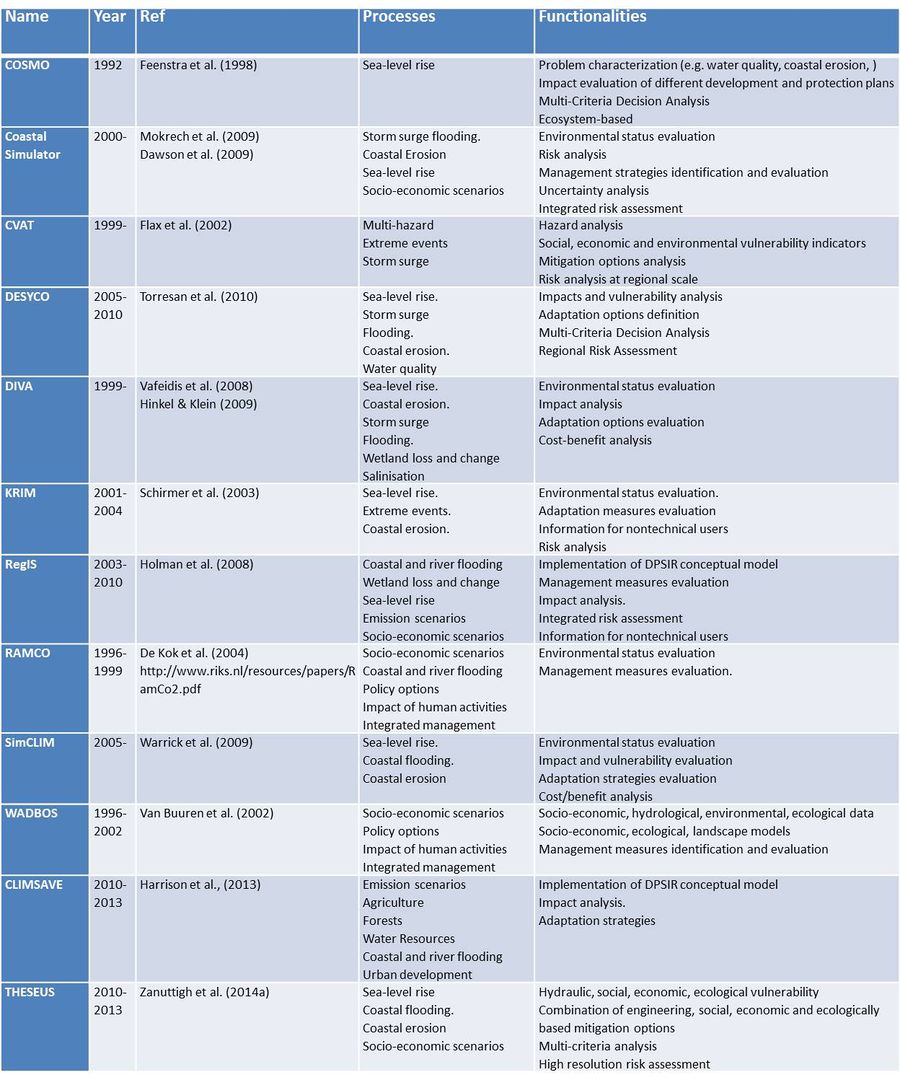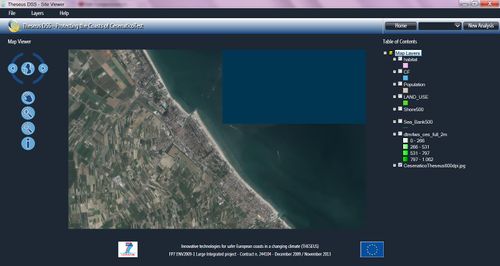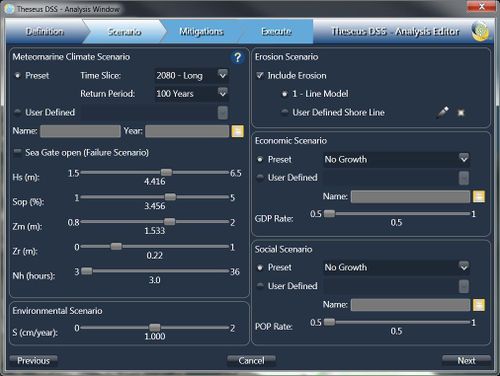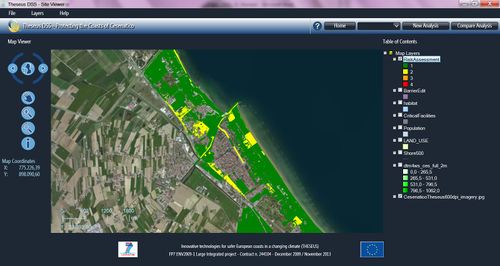Decision Support Systems for coastal risk assessment and management
Contents
Introduction
Policy makers and coastal managers require tools for the rapid assessment of coastal flooding and erosion risk, the prioritisation of areas where interventions are urgently required, the understanding of the effectiveness of the available mitigation and adaptation options, and finally for the selection of the best combination of measures that can promote coastal safety and sustainability in a changing climate. Moreover, improving the adaptive capacity of individuals, groups or organizations requires communicating present and possible trends in risk, building awareness of potential impacts and their implications. To these purposes, the use of Decision Support Systems (DSSs) is becoming more and more widespread in preliminary investigations of risk or as non-technical measures to promote disaster preparedness.
Decision Support Systems (DSSs)
A DSS is an exploratory tool that allows to assess the conditions of a system under a variety of scenarios and the consequences of different adaptation and mitigation measures. A DSS will generally integrate the relevant environmental models, database and assessment tools - coupled within a Graphic User Interface (GUI). Spatial problems such as flood and erosion risk requires a Geographical Information System (GIS) approach which can capture, manipulate, process and display spatial or geo-referenced data facilitating spatial data integration, analysis and visualisation. GIS tools are used either as data managers (i.e. as a spatial geo-database tool) or as an end in itself (i.e. media to communicate information to decision makers). The use of GIS for coastal zone management has expanded rapidly during the past decade (Wright and Bartlett, 2000; Bartlett and Smith, 2004; Wright et al., 2011; Sheppard, 2012).
Objectives
Based on a review of a range of existing DSSs which deal with coastal areas (Table 1), the main objectives of these tools are the analysis of vulnerability, impacts and risks, and the identification and evaluation of related management options, in order to support robust decisions for sustainable management. Specifically, the objectives of the examined DSS tools address three major issues (with examples in brackets from Table 1):
- the assessment of vulnerability to natural hazards and climate change (DIVA, RegIS, CVAT, DESYCO, KRIM, Coastal Simulator, THESEUS);
- the evaluation of present and potential climate change impacts and risks on coastal zones and linked ecosystems, in order to predict how coastal regions will respond to climate change (RegIS, CVAT, Coastal Simulator, THESEUS);
- the evaluation or analysis of management options for the optimal use of coastal resources and ecosystems through the identification of feasible measures and adequate coordination of all relevant users/stakeholders (COSMO, WADBOS, SIMCLIM, RAMCO, THESEUS).
It is worthy to mention the effort of the European Commission delivering a web-platform to promote Climate Adaptation by means of sharing information, best practices, assessment methodologies and adaptation solutions. The resulting tool provides guidance, i.e. it is not a software tool for running specific scenarios at a given area (http://climate-adapt.eea.europa.eu/knowledge/tools/adaptation-support-tool).
THESEUS DSS

Some details about the recently developed THESEUS DSS (www.theseusproject.eu, Zanuttigh et al., 2014a) are given here as an example of how a high-resolution GIS-based DSS for coastal risk assessment and management works.
The THESEUS DSS is based on the following pillars:
- It provides seamless integration across disciplines: physics, engineering, ecology, social sciences and economy.
- It considers intermediate spatial scales (10- 100 km) and short-, medium- and long-term time spans (1-10-100 years).
- It allows diverse combinations of mitigation options such as engineering defences (i.e. barriers, wave farms, etc.), ecologically-based solutions (i.e. biogenic reefs, sea-grasses, etc.) and socio-economic mitigations (i.e. insurance, change of land use, etc.).
- It supports decision-making based on a balance between deterministic models and expert judgement.
The ‘structural’ scheme of the DSS is presented in Fig. 1.
The DSS input database for each site has to include a Digital Terrain model (Fig. 2) – as detailed as possible; hydraulic structures and infrastructures position, geometry; map of land-use including critical facilities; list and/or map of geo-referenced social and economic indicators, such as: age, gender, unemployment rate, education level, health status, etc; geo-referenced maps of habitat types and species including: rare species, rare habitats, commercially important marine habitats, habitats relevant for coastal protection.
Scenarios
THESEUS DSS is based on scenarios analysis (Fig. 3 shows the scenario analysis interface) and specifically includes:
- climate and environmental scenarios, which can be a pre-defined set of conditions derived by scientists (wave height, storm surge, sea level rise, etc.) for short, mid and long term or a set of conditions based on the kind of scenario the user wishes to explore, ordinary or extreme;
- economic and social scenarios, essentially based on expected changes or trends of the population and on the gross domestic product;
- environmental scenarios, provisionally limmited to subsidence; in a future research, the scenarios of the habitat modifications likely to occur based on changes of temperature, social and economic development, etc. may be included.
Interconnecting elements
The DSS needs the definition by the site manager of the following elements (lines, points) that are relevant for modeling the hydraulic processes.
- Waves: boundary conditions have to be prescribed at locations where scenarios are given by the scientists.
- Shoreline and sea-bank line: these lines represent the water/beach boundary needed to estimate beach retreat, and the water/land boundary from which flooding starts, respectively.
- Water sources: one or more punctual sources for each coastal segment, depending on the minimal resolution adopted for describing the area, where flooding will be predicted.
Mitigation options
Mitigations are represented both as changes of pathways and of receptors, and include (Fig. 4 shows the mitigation selection interface):
- engineering mitigations, such as wave farms, barriers, floating breakwaters, sea walls, etc… that affect wave transfer from offshore to shore; these mitigations can directly be drawn by the user (Fig. 5) or uploaded through a shapefile;
- ecologically based mitigations, such as management or construction of dunes, reinforcement of salt-marshes, creation of biogenic reefs; these mitigations can be represented as a change of the habitat map and where applicable also as a change of bottom elevation;
- economic and social mitigations such as evacuation plans, land use change (for instance managed realignment), insurance premium; the user can interact by modifying the insurance premium value, the percentage of evacuated people or the destination of a given area.
Modelling the physical processes
These processes include wave transformation from offshore till the shoreline, beach erosion, wave runup on the beach and overtopping over the sea-bank, and finally flooding. The ‘flooded DEM’ consist of maps of flood depth, duration and velocity of flood propagation, see an example in Fig. 6.
Consequences
THESEUS scientists developed appropriate ‘damage functions’ to link economic, social and ecological data to hydraulic parameters (beach retreat, flood depth, duration, velocity) and produce ‘damage’ maps (actually impact maps since the monetary scale is used only for the economic consequences).
Risk Assessment
The overall risk related to the examined combination of scenarios and mitigations is assessed by means of the multicriteria analysis, which integrates the engineering, social, economic and environmental impacts into the spatial distribution of a semi-quantitative risk indicator, see the map in Fig. 7.
Practical and conceptual challenges
Besides the intrinsic problem of integrating different disciplines with different views and languages, the preparation of a DSS has to face practical and conceptual challenges:
- The conceptual approach and the simplified modeling assumptions that are at the basis of the DSS may be considered too simplistic by coastal managers and stakeholders to trust the reliability of the results. However, the relatively fast running time allows the user to examine many different scenarios so that he/she can identify how and how far the DSS results compare with the historical data and/or the memory in the sites. Moreover, the inherent uncertainty of the results (common to any type of sophisticated model) can be overcome aiming at a sensitivity analysis of the results, i.e. at comparing results of different scenarios considering that all the results are affected by the same simplifying assumptions.
- In many cases, the topographic, social, economic and ecological high spatial resolution data that are required for running the DSS may be not available. Even when available these data may be owned by different authorities (municipalities, regional governments, ministry) and scattered and hard to obtain, due to miscommunication among the owners and confidentiality issues.
- Results based on a single scenario run may lead to erroneous decisions. It is therefore important to warn the users that the best methodological approach consists of running multiple storm scenarios for each selected time slice and by post-processing the results of these scenarios to get the sources-consequences function. Specifically, the social, economic, hydraulic and ecological vulnerability maps obtained for each storm should be multiplied by the probability of occurrence of the corresponding storm and then added to get the average vulnerability maps. Relevant parameters/indicators should be identified and compared to better quantify the effects rather than by the qualitative impression given by the maps (Zanuttigh et al., 2014b).
In conclusion, it should not be forgotten that the DSS is essentially a tool to be used in a preliminary assessment phase. It is not meant to substitute the detailed design process. Hence, the DSS is designed to be part of a stratified analytical approach for coastal risk management.
References
Bartlett, D. and Smith, J.L. (eds.) 2004. GIS for Coastal Zone Management. Routledge, London, 300pp.
Dawson, R.J., Dickson, M., Nicholls, R.J., Hall, J., Walkden, M.J.A., Stansby, P.K., Mokrech, M., Richards, J., Zhou, J., Milligan, J., Jordan, A., Pearson, S., Rees, J., Bates, P.D., Koukoulas, S. and Watkinson, A. (2009) Integrated analysis of risks of coastal flooding and cliff erosion under scenarios of long term change. Climatic Change, 95, (1-2), 249-288. (doi:10.1007/s10584-008-9532-8).
De Kok, J.L., Engelen, G., White, R. and Wind, H. G. (2001). Modelling land-use change in a decision-support system for coastal-zone management. Environ model assess, 6(2):123–132.
Feenstra, J.F., Programme, U.N.E. & Milieuvraagst, V. (1998). Handbook on methods for climate change impact assessment and adaptation strategies, United Nations Environment Programme.
Flax, L.K., Jackson, R.W. & Stein, D.N. (2002). Community vulnerability assessment tool methodology. Natural Hazards Review, 3:163-176.
Harrison, P.A., Holman, I.P., Cojocaru, G., Kok, K., Kontogianni, A., Metzger, M. and Gramberger, M. (2013) Combining qualitative and quantitative understanding for exploring cross-sectoral climate change impacts, adaptation and vulnerability in Europe. Regional Environmental Change, 13, 761–780.
Hinkel, J. & Klein, R.J.T. (2009). Integrating knowledge to assess coastal vulnerability to sea-level rise: The development of the DIVA tool. Global environ chang, 19(3):384–395.
Holman, I.P., Rounsevell, M.D.A., Berry, P.M., Nicholls, R.J. (eds.) (2008). Development and application of participatory integrated assessment software to support local/regional impacts and adaptation assessment. Climatic Change, 90(1/2), 1-187.
Mokrech, Mustafa, Hanson, Susan, Nicholls, Robert J., Wolf, Judith, Walkden, Mike, Fontaine, Corentin, Nicholson-Cole, Sophie, Jude, Simon R., Leake, James, Stansby, Peter, Watkinson, Andrew R., Rounsevell, Mark D.A., Lowe, Jason A. and Hall, Jim W. (2009) The Tyndall coastal simulator. Journal of Coastal Conservation: Planning and Management (doi:10.1007/s11852-009-0083-6).
Schirmer, M., B. Schuchardt, B. Hahn, S. Bakkenist & D. Kraft (2003): KRIM: Climate change risk construct and coastal defence. DEKLM German climate research programme. Proceedings, 269-273
Sheppard, S.R.J., 2012. Visualizing Climate Change: A Guide to Visual Communication of Climate Change and Developing Local Solutions, Routledge, London, 514pp.
Torresan, S., Zabeo, A., Rizzi, J., Critto, A., Pizzol, L., Giove, S. and Marcomini, A. (2010). Risks assessment and decision support tools for the integrated evaluation of climate change impacts on coastal zones. International Congress on Environmental Modelling and Software Modelling for Environmental Sake, Fifth Biennial Meeting, Ottawa, Canada.
Vafeidis, A. T., Nicholls, R. J., McFadden, L., Tol, R. S. J., Hinkel, J., Spencer, T., Grashoff, P. S., Boot, G. and Richard J.T. (2008) A new global coastal database for impact and vulnerability analysis to sea-level rise. Journal of Coastal Research, 24, (4), 917-924. (doi:10.2112/06-0725.1).
van Buuren, J.T., Engelen, G. & van de Ven, K. (2002). The DSS WadBOS and EU policies implementation.
Warrick, R. A. (2009): Using SimCLIM for modelling the impacts of climate extremes in a changing climate: a preliminary case study of household water harvesting in Southeast Queensland. 18th World IMACS/MODSIM Congress, Cairns, Australia 13-17, July 2009.
Wright D. and Bartlett D., 2000, Marine and Coastal Geographical Information Systems. (London: Taylor and Francis).
Wright, D.J., Dwyer, E., and Cummins, V. (eds.), 2011. Coastal Informatics: Web Atlas Design and Implementation, Hershey, PA: IGI-Global, DOI: 10.4018/978-1-61520-815-9, ISBN13: 9781615208159, 350 pp.
Zanuttigh B., Simcic D., Bagli S., Bozzeda F., Pietrantoni L., Zagonari F., Hoggart S., Nicholls R. J., 2014a. THESEUS decision support system for coastal risk management, Coastal Engineering, 87, 218-239, Elsevier.
Zanuttigh B., Martinelli L., Bozzeda F., Colangelo M. A., Pietrantoni L., Zagonari F., Prati G. 2014b. Chapter 7. Case studies worldwide. Section 7.6 Risk Assessment and Mitigation in a Low-lying Coastal Area: Cesenatico, Northern Italy. in “Coastal risk management in a changing climate”, Zanuttigh B., Nicholls R., Vanderlinden J. P. editors, 472-505. DOI: 10.1016/B978-0-12-397310-8.00007-5
Related articles
- Decision support tools
- Integrated Coastal Zone Management (ICZM)
- Vulnerability and risk
- Science-Policy Interaction
- Valuation and assessment of biodiversity
- Policy instruments for integrated coastal zone management
External link
Spicosa System Approach Framework
Please note that others may also have edited the contents of this article.
|






